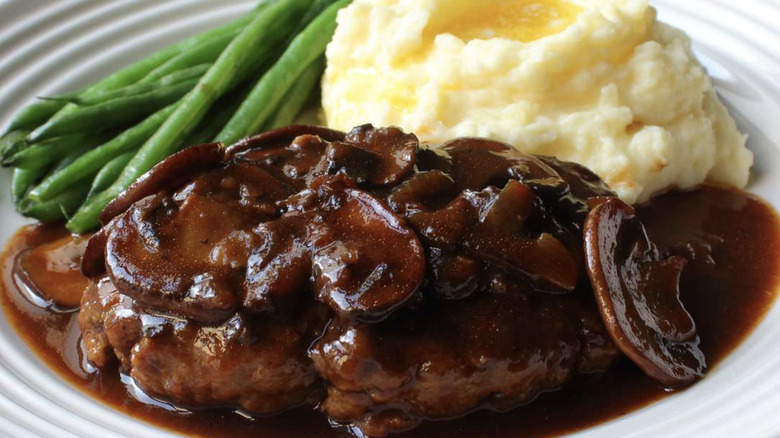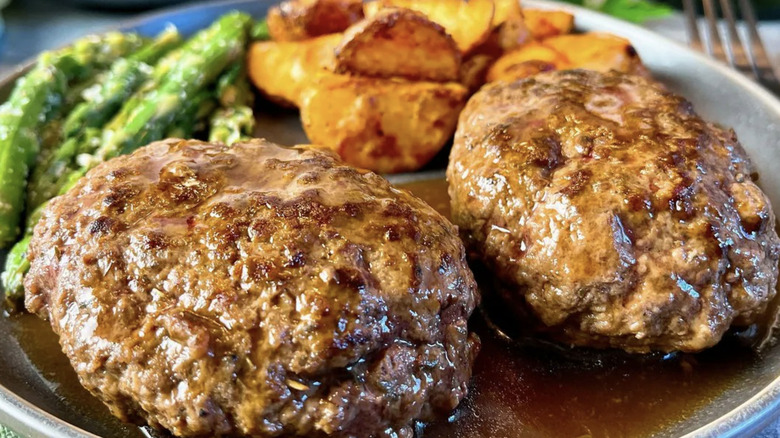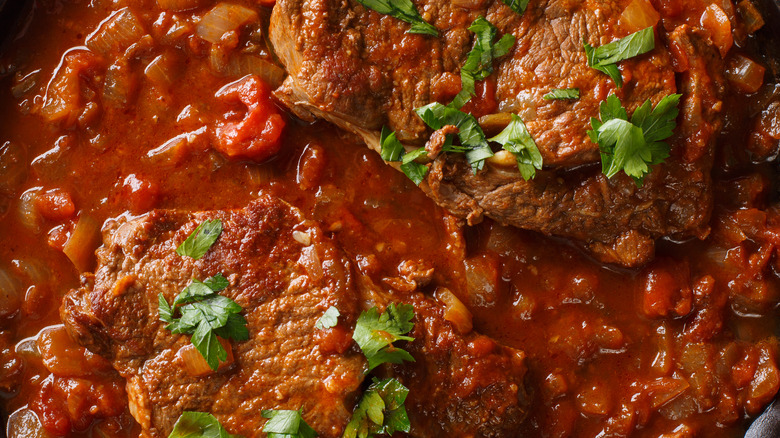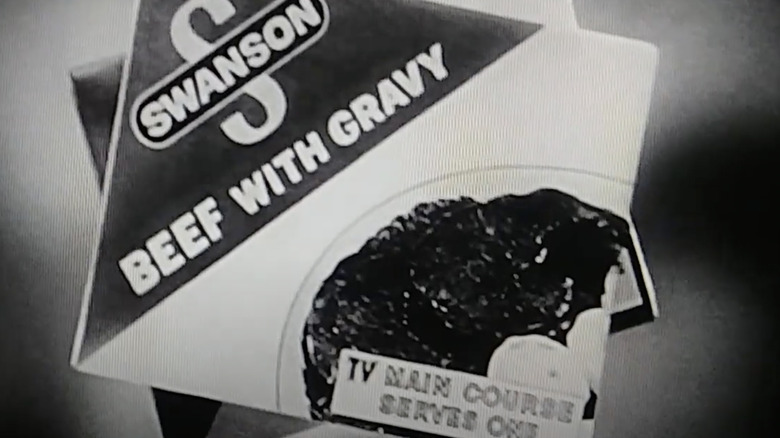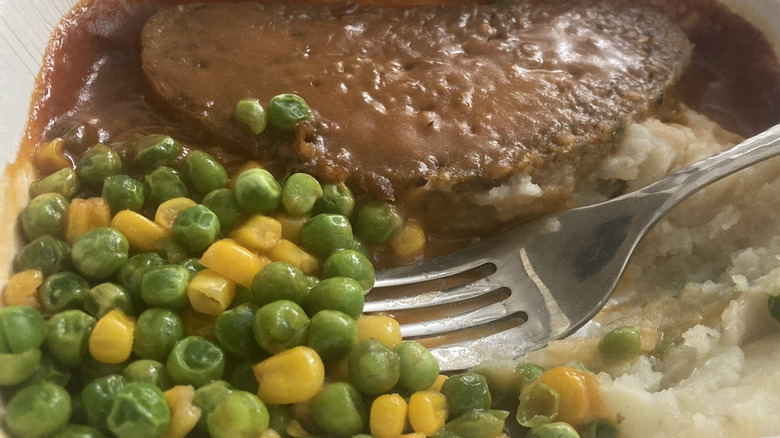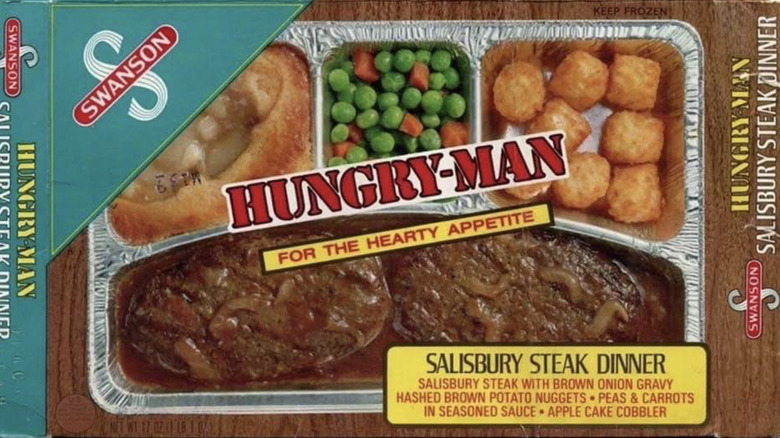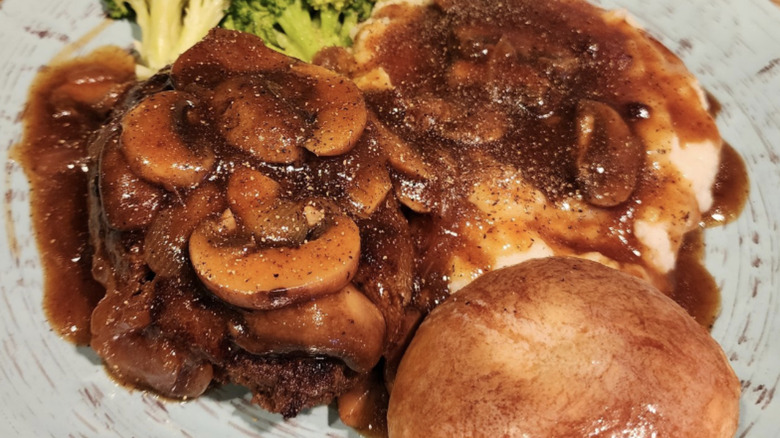The Strange Untold History Of Salisbury Steak
If you've ever peeled back the cellophane and dug into the pre-portioned goodness of a classic TV dinner, chances are you're familiar with Salisbury steak. For better or worse, TV dinners have kept this retro entrée relevant, but there's so much more to Salisbury steak than meets the eye. For starters, it's way older than you may realize. Back in the mid-1800s, Dr. James Henry Salisbury, an early proprietor of the "food as medicine" ethos, introduced the minced beef dish as a cure for stomach illnesses and digestive troubles. He christened his steak creation as "muscle pulp of beef", but what the 19th-century medical professional may not have realized was that his proposed diet food — which would later be named Salisbury steak in his honor — would become a cornerstone of TV dinners for generations.
Between its Civil War-era inception and its well-worn slot in the freezer aisle, Salisbury steak was a popular family-style dinner and school cafeteria item. The hunks of hamburger-like meat smothered in mushroom gravy served as a broiled or fried alternative to oven-baked slices of meatloaf. Let's glimpse back in time to learn more about how the Salisbury steak went from a medical experiment to homemade comfort food, to a TV dinner legend. We'll dive into the steak's strange history, and take a look at where it's headed in the future.
Salisbury Steak was believed to help fight disease in Civil War soldiers
In the Civil War era, intestinal ailments were common in soldiers who subsisted on a nutrient-low diet consisting of military-issued biscuits and the like. Believe it or not, digestive illnesses like dysentery killed more soldiers during the Civil War than battlefield combat. As an early follower of germ theory, New York-born Dr. Salisbury was adamant in his belief that food (which he referred to in his studies as "alimentation") could serve a medicinal purpose. Salisbury was at the forefront of this kind of research, so he performed most of his early diet trials on himself and other willing test subjects.
One such trial consisted of Dr. Salisbury eating nothing but baked beans for a few days, which wreaked havoc on his digestive system and overall well-being. In another trial, test subjects consumed only porridge for about 30 days. Salisbury had his "eureka" moment when he tested a singular diet of lean, minced beef which he determined to be the choice alimentation for easy human digestion. Salisbury began to distribute portions of what he called "muscle pulp of beef" to Union Army soldiers to provide them with sustenance, while also curing and preventing potentially lethal intestinal diseases. He continued to research the topic for a good 30 years. Although the Civil War had ended decades earlier, Salisbury published his findings in the 1888 tome "The Relation of Alimentation and Disease".
Dr. Salisbury and his steak were early pioneers of the fad diet
Dr. Salisbury's book about the digestive powers of mincemeat was a hit. The public was impressed by his findings and patties of "muscle pulp of beef" began to be perceived as a cure for intestinal discomfort. The food was eventually renamed "Salisbury steak" in honor of its creator, and is considered one of the first American fad diets. Tired of shoveling in nothing but forkfuls of Salisbury steak? Dr. Salisbury suggested that eaters could switch to boiled mutton for a similar effect (yum!).
As civilians adopted Salisbury's low-carb dietary principles from "The Relation of Alimentation and Disease", the steak patty's status as a nutritious military meal continued. The "General Mess Manual And Cookbook: For Use On Board Vessels Of The United States Navy", first published in 1904, included a recipe for Hamburger Steak (tinned mutton gets its fair share of recipes, too). 1945's edition of "The Cookbook Of The United States Navy" gives Dr. Salisbury a direct shoutout with the inclusion of a recipe for Griddle-Broiled Salisbury Steaks. Salisbury, who died in 1905, recommended eating "muscle pulp of beef" three times a day, and consuming it with hot water to amp up its digestive cleansing ability. While this may help alleviate acute stomach afflictions, like many fad diets, it doesn't sound realistically sustainable long-term.
What's the difference between a Salisbury steak and a hamburger steak?
The American Industrial Revolution of the mid to late 19th century saw access to meat grinders becoming more widespread than it was in days past, but the truth is, a pounded meat dish called the Hamburg steak (later known as hamburger steak) was being cooked up in Europe around the same time Dr. Salisbury began promoting chopped beef's healing properties. As its name gives away, Hamburg steak has origins in Hamburg, Germany where it was known to be a popular dish in the mid-1800s. It was introduced to U.S. kitchens through sailors and immigrants who landed in Boston and New York City, and started showing up American in cookbooks and on restaurant menus throughout the 1870s and 1880s.
A traditional hamburger steak is hand-pounded rather than ground or minced like a Salisbury steak, and then mixed with fried, finely chopped onions. When the hamburger as a sandwich took the states by storm at the onset of the 20th century, the hamburger steak's signature pounded texture began to shapeshift, and was often swapped for ground "hamburger" meat. Now, most hamburger steak recipes call for ground beef patties mixed with bread crumbs and onions before being pan-fried. Essentially, the hamburger steak — sometimes called the poor man's steak — is a cross between fried meatloaf and a bunless burger.
Where is Swiss steak's place in all of this?
Swiss steak joined hamburger steak and Salisbury steak as typical family dinner fare in American homes in the mid-1900s. The differences between hamburger steak and Salisbury steak are slight yet still well-defined, but what about Swiss steak? It stands apart from the other two steaks for a few reasons. While hamburger steak and Salisbury steak gained popularity back in the 19th century, one of the earliest known records of Swiss steak's existence is from a recipe printed in 1915.
Another distinction is that it has a different texture — which also plays into how Swiss steak got its name (spoiler alert: it's not from Switzerland). Swiss steak is a top round or rump cut of beef that is tenderized by a method referred to as swissing. Rather than being fed through a grinder à la Salisbury steak, or pounded into submission Hamburg-style, swissing requires putting this rough cut of steak through a machine equipped with tiny blades. The incisions made from the blades break up the connective tissues responsible for the meat's less-than-ideal consistency. Hamburger and Salisbury steaks are fried or broiled and usually served with a healthy pour of beef-based onion or mushroom gravy. Swiss steak is browned in oil and then braised or baked in a stew-like sauce of tomatoes and onions. In modern times, home-cooked Swiss steak is often prepared in a crock pot or Dutch oven.
Salisbury steak became popular again during World War I and the Great Depression
Hamburger steak is bad, Salisbury steak is good, Swiss steak ... neutral? This wouldn't be the first or last time that food got political. During World War I, Americans said auf Wiedersehen to culinary words heavy with German influence. Frankfurters were renamed "hot dogs" (which turned out to have quite a ring to it), sauerkraut changed into "liberty cabbage", hamburgers were "liberty sandwiches", and the mighty hamburger steak amorphously banded with its patriotic cousin Salisbury steak.
Salisbury steak's spike in popularity was prolonged by the Great Depression, which hit the U.S. hard in 1929 — just 11 years after World War I ended. This was a time when resources were scarce, and Americans got creative with undecadent ingredients. Salisbury steak fit in with other Great Depression foods because it used inexpensive cuts and processing methods of beef. To intensify matters, the U.S. government started a nationwide food rationing system in the spring of 1942 due to the nation's looming involvement in World War II. It didn't take long for meat to be added to the ration list, which motivated Americans to stretch what they had as far as it could possibly go. Salisbury steak continued to be a go-to meal because it fed a whole family, and took well to being cut with oats or cream of wheat while still eating like a protein-forward dinner.
Frozen dinners emerged in the 1940s and Salisbury steak was an early star
The Salisbury steak nourished American soldiers and civilians throughout some of the most challenging times in the nation's history, but in the post-war era, its role would completely change with the rise of TV dinners. Clarence Birdseye changed the frozen food game in the mid-1920s with his invention of the double belt freezer, but his namesake frozen food empire is not credited with creating the first frozen dinner. That milestone belongs to Maxson Food Systems, a Long Island-based company that used the double belt freezer to make complete frozen meals called Strato-Plates in 1945. These compartmentalized trays of meat, potatoes, dessert, and a vegetable were first marketed as airplane food. As the '40s drew to a close, frozen dinner trays would turn up as bar food courtesy of Jack Fisher's FridgiDinners, and as a regional novelty around Pittsburgh thanks to Albert and Meyer Bernstein.
It was mega-brand Swanson that launched this idea into greatness in 1954 when it sold frozen turkey as part of a compartmented aluminum tray meal, coining the term "TV dinner" in the process. Turkey was the original meat source of a TV dinner — sold 10 million units in its first year — but with the convenience over cooking trend showing no sign of slowing, variety was key. In the early days, Swanson TV dinner choices were centered around turkey, fried chicken, meatloaf, or Salisbury steak.
Salisbury steak is permanently associated with TV dinners
The name TV dinner was inspired in part by the booming number of televisions that began to appear in more and more homes during the 1950s, and people's tendency to gather around it — even at dinnertime. It was also a decade when American women were joining the workforce by the millions, which meant fewer married ladies were available to prepare dinner for their husbands and kids.
Just as the Salisbury steak had a place in the 19th-century diet and the Great Depression era, it was also right at home in the rapidly expanding TV dinner industry — possibly too at home. Banquet, a company known for its frozen meat pies, quickly modified its business strategy to include TV dinners like southern-fried chicken, and of course, Salisbury steak. Whether you were a kid whose parents worked late, a 20-something single person, or simply too tired to cook after a long day, these frozen meals were a quick dinner solution, and often the only way people ate Salisbury steak. Newer brands like Stouffers and Marie Callender's hopped on the TV dinner scene, and sold a frozen version of Salisbury steak as well. Today, Salisbury steak remains a popular choice for frozen TV dinners, but due to being so closely associated with the freezer aisle, it's lost its relevance as a homemade dinner.
Fresh or frozen, the Salisbury steak is no longer considered a health food
Dr. Salisbury might have rolled over in his grave if he knew that not only is Salisbury steak no longer considered medicinal, it's also pretty unhealthy. Flip over the box of a frozen dinner Salisbury steak, and you'll see a lot of sodium, a lot of cholesterol, and depending on the brand, ingredients ranging from the confusing: textured vegetable protein, and mechanically separated chicken, to the concerning: monosodium glutamate (MSG). Surely, this is not what Dr. Salisbury had in mind back in the 1800s when the steak was eaten without gravy, but processed foods rife with sodium and preservatives have long been what TV dinners are all about.
If you had any doubt, consider the fact that the Environmental Working Group (EWG) rates Swanson's Hungry Man Salisbury Steak frozen dinner (a larger portion for the hungrier human) a 10 on its concern level scale — the worst score possible on account of its hardcore sodium level, the likelihood of growth hormones in the meat, and heavily processed nature. Even if you give frozen dinners the cold shoulder and opt to cook a Salisbury steak on your own, the ground meat and gravy are still high in salt and saturated fat. The modernized version of Salisbury steak is comfort food more than fad diet fodder, so it's more of a special occasion food than a daily meal (sorry doc!).
The unforeseen rise of TV dinners (and Salisbury steak) is brought on by COVID-19
No one could have predicted this chapter in Salisbury steak's history. When COVID-19 gripped the planet, and isolated civilization as we know it, normal habits like weekly grocery runs became risky, dystopian-tinged events. What do people who want to minimize their grocery store trips buy? Frozen food.
TV dinners and other freezer items were in high demand during the pandemic, and shoppers who didn't typically reach for pre-made frozen meals were suddenly keeping a stack or two on hand. Though the circumstances were tragic, TV dinners made a comeback during COVID-19, and the Salisbury steak was ready and waiting. The sale of frozen food increased by 21% in the first year of the pandemic and raked in $72.2 billion in 2022 alone. Frozen meals have evolved by leaps and bounds since the 1950s, but in a time of such uncertainty, retro foods like meatloaf and Salisbury steak served in a TV dinner tray provided comfort to many in a whole new way.
Some restaurants specialize in Salisbury steak entrées
We know all about Salisbury steak's swaggering prowess in the frozen food domain, but does that mean this is all it can ever be? Certain restaurants beg to differ. One example is Grand Lux Cafe, a sit-down chain with various locations that include Las Vegas, Chicago, New York, Dallas, and Houston. Grand Lux Cafe sees value in the classics and keeps Salisbury steak on its menu, along with other homestyle gems like braised pot roast.
Then there's the unexpected route. Hip New York eatery C as in Charlie makes Salisbury steak cool again with a praiseworthy fusion called the Seoul'sbury steak. This dish is a playful marriage of Korean and Southern flavors that honor the owners' Asian heritage and Atlanta roots. The Seoul'sbury steak isn't plated with the run-of-the-mill green veggies and mashed potatoes, instead, it sits on a bed of savory Gruyère grits and features a Korea-inspired galbi jus in place of the all-American mushroom gravy. In case you were wondering how the public feels about Seoul'sbury steak — they love it.
Other countries have their own version of Salisbury steak
Salisbury steak as the muse for culinary fusion seems less out there when you consider that the humble entrée has quite a history outside of the United States. Japan's representation of Salisbury steak, known as hambagu, is nothing short of huge in its national cuisine. Hambagu proudly draws inspiration from the West, with its earliest known influences dating back to the 18th-century steak tartare dishes popularized by Germans in Hamburg — the influence that would later bring hamburger steaks to America. Hambagu recipes call for the beefsteak to be mixed with onion, panko breadcrumbs, and egg (like a meatloaf) but revert to the Salisbury steak side of things when doused in mushroom gravy and served with mashed potatoes and greens. It's common to find hambagu in cafeterias and restaurants in Japan. For instance, the cowboy-inspired Japanese burger chain Bronco Billy has had a hambagu steak on its menu for years. Korea's version of Salisbury steak, called hambak steak, closely resembles hambagu with the main distinction being that it is traditionally served with rice, rice cakes, potato salad, or coleslaw on the side.
Germany paved the way for hamburger's world domination, but Hamburg steaks go by another name in the motherland. Small ground beefcakes seasoned and pan-fried are known in Germany as frikadelle or bulette (which translates to meatball), and are eaten hot or cold. Frikadelle is primarily made from beef, but bison or a beef and pork combination are also used.
What does the future hold for Salisbury steak?
With such a storied legacy, it's not surprising that Salisbury steak gets labeled as vintage comfort food. Salisbury steak as a TV dinner is almost certainly here to stay, and that's not a bad thing, but in the 21st century, it wouldn't hurt to broaden our expectations of this historical meal. The internet agrees. Chef John's YouTube channel "Food Wishes" has a Salisbury steak recipe, and encourages its 4.4 million subscribers to cook the hamburger specialty at home. Recipes for vegan Salisbury steak are also plentiful online, especially in the wake of massive interest in ground beef substitutes like the one from Impossible Foods.
Aficionados of ready-made meals can enjoy elevated Salisbury steak too. CookUnity, a pre-made meal service providing chilled, not frozen dishes, teams up with award-winning chefs to showcase an eclectic repertoire of meals — one of which is a Salisbury steak dinner. The Salisbury steak entrée is from New York City-born chef Anthony Nichols, who elevated the frozen Salisbury steak he grew up eating by using high-quality ingredients, adding caramelized onions, more sauce, and coupling it with refined sides like sweet pea mash, celery root, and parsnip purée. Time and time again we've seen kitschy throwback items saunter back into the spotlight, boosted by a renewed interest from the younger generation. Does Salisbury steak deserve another turn as a food of the moment more than 100 years after its legendary creator's death? We think so.
